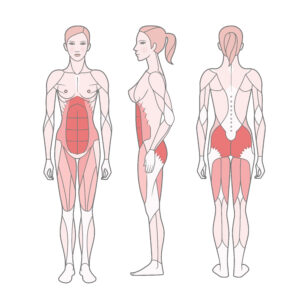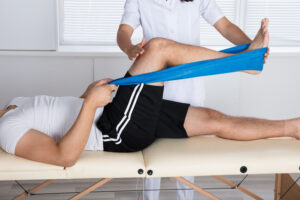Does strengthening your core help with low back pain?

 For our expert osteopaths in Bath the most common symptom we treat is low back pain, in fact approximately half of the patients we see are seeking help with low back pain (1). The most common recommended treatments for sufferers of low back pain are exercise, spinal manipulation/mobilisation, advice, and guidance about the condition, and advice on continuing with normal activities (2). We have written an article on different types of exercise and their effect on low back pain but in this article, we wanted to explore whether or not specifically strengthening your core will help if you have low back pain.
For our expert osteopaths in Bath the most common symptom we treat is low back pain, in fact approximately half of the patients we see are seeking help with low back pain (1). The most common recommended treatments for sufferers of low back pain are exercise, spinal manipulation/mobilisation, advice, and guidance about the condition, and advice on continuing with normal activities (2). We have written an article on different types of exercise and their effect on low back pain but in this article, we wanted to explore whether or not specifically strengthening your core will help if you have low back pain.
We are specifically going to examine the effects of improving core strength in sufferers of chronic low back pain, both of which are defined as;
Structures of the ‘core’
Often the core is defined as being the combination of the deep transverse abdominus muscle, the pelvic floor, and the diaphragm, however, it also includes the larger muscles of the abdomen, low back, hamstrings, and hip flexors (3, 4). Exercises that target strengthening these structures are what we consider core strengthening
Chronic low back pain
This is pain between the top of the pelvis and the bottom of the ribcage that has been present for over twelve weeks, even after the reason for the cause of the pain has been resolved. For this reason, it is also referred to as non-specific low back pain (more on this later) (5).
How does your core work?
Core strength works to help your body produce more controlled and precise movements by giving it a stable centre to work from. The contraction of your core muscles facilitates a stiffening of abdominal area and spine that allows the arms and legs to move in more effective ways (6). Think about throwing a rugby ball, if you do it on two legs you can produce a large amount of force and accuracy, now try it on one leg and you will see that due to the lack of stability you cannot replicate the same level of performance, this gives you an idea about how an increase in stability can help with movement.
 Does strengthening your core help with chronic low back pain?
Does strengthening your core help with chronic low back pain?
The causes of chronic low back pain are varied and complex, one of the reasons it occurs is a lack of power and contraction of the muscles of the core/trunk as sufferers of chronic low back pain show different activity rates in the muscles of the core compared to people with no low back pain (7, 8). With this in mind, you would think it would be safe to assume that strengthening the core muscles would reduce chronic low back pain. The truth is that the research is fairly non-committal due to the variability of the types of exercises used making any inference difficult (9). Another problem is that when studied there is a large amount of variability in how people’s pain changes when they improve their core strength. Both these factors mean that the general thought is that core strengthening probably helps reduce chronic low back pain but more research is necessary to determine by how much and who will benefit most (10).
Moving away from pain as a measure, core strengthening is cited as being a vital part of the treatment for various hip, knee, ankle, and shoulder problems (11, 12). Also, when looking at the effect of core strengthening on people’s ability to complete tasks such as stair climbing and occupational tasks there is a much larger improvement. Both of these things show that a strong core is important for performing a range of tasks and movements.
How would I know if increasing my core strength will help with MY back pain?
We use core/trunk strength training for SOME of our patients, and how we use it may help explain the variability in the research into this subject. If all chronic/non-specific low back pain sufferers are lumped into the same study group there is no way to delineate who would benefit most from strengthening their core. When we assess people who come into our clinic with chronic low back pain we are able to perform a set of tests that not only tell us if they require an increase in core stability, but also which specific exercises are necessary to strengthen the areas they are lacking stability in. This removes the two issues highlighted by the research that was changing their results and makes our treatment of chronic low back pain using core strengthening much more effective than the research outcomes.
subject. If all chronic/non-specific low back pain sufferers are lumped into the same study group there is no way to delineate who would benefit most from strengthening their core. When we assess people who come into our clinic with chronic low back pain we are able to perform a set of tests that not only tell us if they require an increase in core stability, but also which specific exercises are necessary to strengthen the areas they are lacking stability in. This removes the two issues highlighted by the research that was changing their results and makes our treatment of chronic low back pain using core strengthening much more effective than the research outcomes.
Do you want to know what is causing your pain and if we can help? Why not take advantage of our new patient assessment introductory offer to get you started towards a tailor made recovery plan for only £19.
Are you in a lot of pain and want to get better as soon as possible? If so then why not book in for a new patient consultation, with treatment on the day, for £75.
Ref
1 – Fawkes C, Carnes D. Patient reported outcomes in a large cohort of patients receiving osteopathic care in the United Kingdom. PLoS One. 2021 Apr 16;16(4):e0249719. doi: 10.1371/journal.pone.0249719. PMID: 33861778; PMCID: PMC8051759.
2 – NICE Guidelines. Low back pain and sciatica in over 16s: assessment and management, 2020. Available at; https://www.nice.org.uk/guidance/NG59/chapter/Recommendations#non-invasive-treatments-for-low-back-pain-and-sciatica
3 – Akuthota V, Nadler SF. Core strengthening. Archives of physical medicine and rehabilitation. 2004 Mar 1;85:86-92.
4 – Hodges PW. Is there a role for transversus abdominis in lumbo-pelvic stability?. Manual therapy. 1999 May 1;4(2):74-86.
5 – Senna, M. and Machaly, S. (2011). Does maintained spinal manipulation therapy for chronic non-specific low back pain result in better long term outcome? Spine, Vol 36, No 18, pp1427-1437.
6 – Zattara M, Bouisset S. Posturo-kinetic organisation during the early phase of voluntary upper limb movement. 1. Normal subjects. Journal of Neurology, Neurosurgery & Psychiatry. 1988 Jul 1;51(7):956-65.
7 – 12) Lee CW, Hwangbo K, Lee IS: The effects of combination patterns of proprioceptive neuromuscular facilitation and ball exercise on pain and muscle activity of chronic low back pain patients. J Phys Ther Sci, 2014, 26: 93–96
8 – Kumar SP: Efficacy of segmental stabilization exercise for lumbar segmental instability in patients with mechanical low back pain: a randomized placebo controlled crossover study. N Am J Med Sci, 2011, 3: 456–461.
9 – Chang, Wen-Dien et al. “Core strength training for patients with chronic low back pain.” Journal of Physical Therapy Science 27 (2015): 619 – 622.
10 – Kumar, Suraj & Kumar, Tarun. (2014). Efficacy of core muscle strengthening exercise in chronic low back pain patients. journal of back and musculoskeletal rehabilitation. 28. 10.3233/BMR-140572.
11 – Huxel Bliven, Kellie C. and Barton E. Anderson. “Core Stability Training for Injury Prevention.” Sports Health 5 (2013): 514 – 522.
12 – Niederbracht, Yvonne et al. “Effects of a Shoulder Injury Prevention Strength Training Program on Eccentric External Rotator Muscle Strength and Glenohumeral Joint Imbalance in Female Overhead Activity Athletes.” Journal of Strength and Conditioning Research 22 (2008): 140-145.

 Does strengthening your core help with chronic low back pain?
Does strengthening your core help with chronic low back pain?